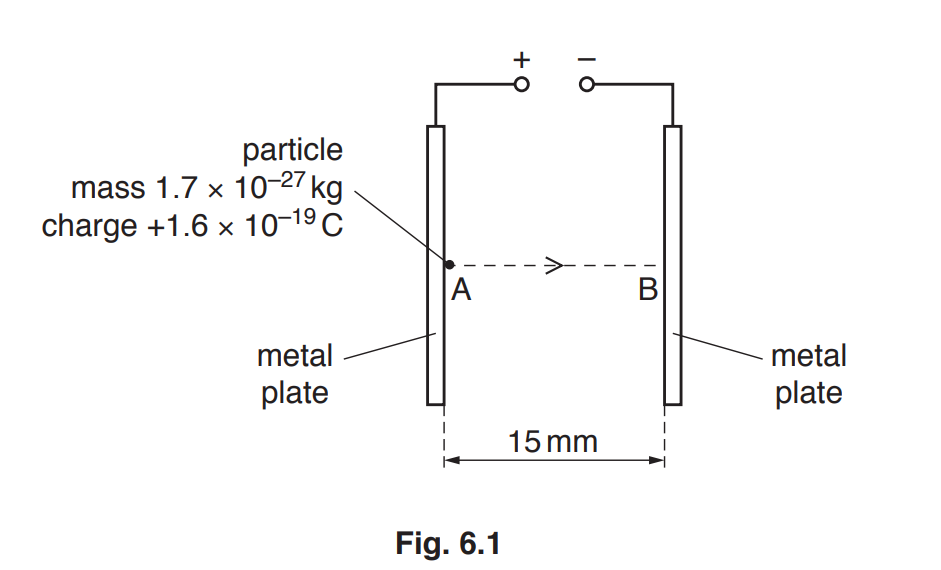Question
A uniform electric field is produced between two parallel metal plates. The electric field strength is 1.4 × 104NC–1. The potential difference between the plates is 350V.
(a) Calculate the separation of the plates.
separation = …………………………………………….. m
(b) A nucleus of mass \(8.3 × 10^{–27}\) kg is now placed in the electric field. The electric force acting on the nucleus is \(6.7 × 10^{–15}\)N.
(i) Calculate the charge on the nucleus in terms of e, where e is the elementary charge.
charge = ……………………………………………… e
(ii) Calculate the mass, in u, of the nucleus.
mass = ……………………………………………… u
(iii) Use your answers in (b)(i) and (b)(ii) to determine the number of neutrons in the nucleus.
number = …………………………………………………
Answer/Explanation
(a)
E = V / d
d = 350 / 1.4 × 104
= 0.025 m
(b)(i)
E = F / Q
Q = 6.7 × 10–15 / 1.4 × 104 (= 4.8 × 10–19 C)
= (4.8 × 10–19 / 1.6 × 10–19) e
= 3.0 e
(b)(ii)
mass = 8.3 × 10–27 / 1.66 × 10–27
= 5.0 u
(b)(iii)
number = 5 – 3
= 2
Question
(a)Define electric field strength.
…………………………………………………………………………………………………………………………………
…………………………………………………………………………………………………………………………………
(b) Two parallel metal plates in a vacuum are separated by a distance of 15mm, as shown in Fig. 6.1.

A uniform electric field is produced between the plates by applying a potential difference between them.
A particle of mass 1.7 × 10–27 kg and charge +1.6 × 10–19C is initially at rest at point A on one plate. The particle is moved by the electric field to point B on the other plate. The particle reaches point B with kinetic energy 2.4 × 10–16 J.
(i)Calculate the speed of the particle at point B.
speed = …………………………………………. ms–1
(ii) State the work done by the electric field to move the particle from A to B.
work done = ………………………………………………. J
(iii) Use your answer in (ii) to determine the force on the particle.
force = ……………………………………………… N
(iv) Determine the potential difference between the plates.
potential difference = ……………………………………………… V
(v) On Fig. 6.2, sketch a graph to show the variation of the kinetic energy of the particle with the distance x from point A along the line AB.
Numerical values for the kinetic energy are not required.

Answer/Explanation
(a)
force per unit positive charge
(b)(i)
\(E_K = \frac{1}{2}mv^ 2\)
2.4 × 10–16 = ½ × 1.7 × 10–27 × v 2
v = 5.3 × 105 ms–1
(b)(ii)
work done = 2.4 × 10–16 J
(b)(iii)
W = Fs
F = 2.4 × 10–16 /15 × 10–3
= 1.6 × 10–14 N
(b)(iv)
V = Fd /Q
or
V =W/Q
or
E =V/d and E = F/Q
V = (1.6 × 10–14 × 15 × 10–3 )/1.6 × 10–19 or 2.4 × 10–16 /1.6 × 10–19
= 1500 V
(b)(v)
straight line with positive gradient starting at the origin and going as far as x = 15mm
